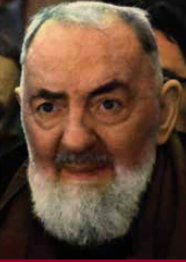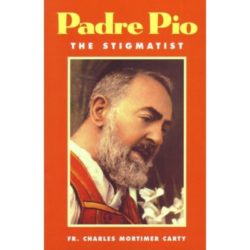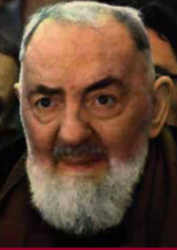 As told to: Joseph Albino
As told to: Joseph Albino
My family comes from Pietrelcina, which is also the hometown of Padre Pio in southern Italy. Pietrelcina is near the larger town of Benevento, and both towns are in the region of Campagna, as Italy is divided into various regions. When people grow up in the small villages of Italy, it is though they all belong to one big, extended family. For example, my mother has the same last name, De Nuncio, as Padre Pio’s mother. Padre Pio’s last name was Forgione.
I myself was born in Bologna in northern Italy and raised there, but also lived in Pietrelcina during summers. In the early 1960’s, when I was eight, my family immigrated to the United States and settled in New Jersey. The biggest grace for our family is that we knew Padre Pio well and were immersed in the oral tradition of Padre Pio, so to speak. My grandfather, in particular, knew Padre Pio very well. They were contemporaries and good friends. As a young woman, my mother used to frequent San Giovanni Rotondo and would spend months at a time there where Padre Pio’s Capuchin monastery, Our Lady of Grace, was located, which is about a three-hour drive from Pietrelcina.
A lot of the people from Pietrelcina–what we would call Paisani, people from the same hometown–would go to visit Padre Pio and spend time with him. They would attend Mass at the Friary Chapel and would go to confession to the Capuchin Friars and would also seek spiritual direction from the Friars. The Capuchins are a reform of the Franciscan order. They began in the early 1500’s and opened friaries in southern Italy, including San Giovanni Rotondo, which was a desolate city on top of a hill in 1500, but is a big city today. Thus, my family was deeply involved in the culture of the Capuchin Friars and knew them well. As a young boy, my grandfather and my parents used to take me to visit Padre Pio, and I received my first Holy Communion from him. However, the biggest gift for me is that I have been able to get to know him through the people who were really close to Padre Pio.
Living Crucifix
In 1918, when Padre Pio was 31, he was praying before a crucifix when Our Lord appeared to him and pierced him through his hands, his feet, and his side. In other words, Padre Pio received all five wounds of Christ. Prior to that in 1910, while already a priest, Padre Pio had received the wounds invisibly while he was at prayer and living at Pietrelcina. Padre Pio became a living crucifix, and I think that is the deepest message of his life. Those stigmata wounds tie him and us to the passion of Christ, to Jesus’ suffering and death. It was Jesus’ suffering and death that redeemed us.
Even when Padre Pio was a young priest he had a great desire to participate in the sufferings of Christ. He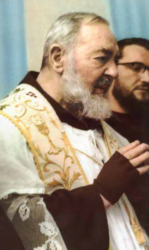 wanted to offer his whole life as a victim soul for others and for the Church. In other words, he wanted to suffer with Jesus for others. That thought is also reflected in the words of St. Paul who, writing in Colossians (I: 24), said that he was willing to suffer for others to make up for what was lacking in the sufferings of Christ. Throughout history, many, many saints have participated in the passion of Christ.
wanted to offer his whole life as a victim soul for others and for the Church. In other words, he wanted to suffer with Jesus for others. That thought is also reflected in the words of St. Paul who, writing in Colossians (I: 24), said that he was willing to suffer for others to make up for what was lacking in the sufferings of Christ. Throughout history, many, many saints have participated in the passion of Christ.
When Padre Pio first received the wounds visibly in 1918, he thought he was going to bleed to death, for the wounds were obviously bleeding and causing a lot of pain. When you read the letters that Padre Pio wrote to his spiritual director, his prayer was that Jesus would take away the external signs of the suffering, but not the pain. He was concerned that he would become an object of curiosity and people would just want to see the stigmata. Rather than show the wounds to others as a sign of “look at me” in order to draw attention to himself, Padre Pio always wore gloves which were actually half mittens made out of wool. He only took the gloves off during Mass. When you see pictures of Padre Pio celebrating Mass, you can tell he does not have the gloves on. However, the sleeves of his vestments were long and covered the palms of his hands. The only time you saw the wounds was when he raised his hands in prayer. Padre Pio also wore socks with his sandals in order to absorb the blood from the wounds.
I have one of the gloves that Padre Pio wore. The glove came from an older woman from Pietrelcina who lived in Staten Island. She obtained the glove from a close priest friend who in turn, was a close friend of Padre Pio. Before this woman died, she gave me the glove. When I give a mission, I bless people with the glove in order to invoke the intercession of Padre Pio before the Lord. However, our faith is not in relics, such as the glove, but in Christ. He’s the object of faith, not the sacraments. In and through the sacraments, we receive His Grace. That was Padre Pio’s message. Of course, all Christians participate in Jesus’ life by their own sufferings and struggles. However, Padre Pio participated in these sufferings in a visible, concrete way. And that is why, I think, Our Lord gave him such great gifts such as the ability to read hearts.
Eye to Your Soul
People who had never met him and people he never knew would go to visit Padre Pio. Though it didn’t happen to everyone, often Padre Pio would look into your eyes and read to you your soul. He would tell you your whole life, your sins, whether you were in the state of grace, and if you were displeasing or pleasing to the Lord. This experience happened to many, many people who came to visit Padre Pio. Often times, many people who personally knew Padre Pio would call upon him for assistance even when they were a million miles away. Later they would meet with Padre Pio and would say, “Father, I was in a difficult situation, and I called upon you for assistance.” Padre Pio would reply, “You think I’m deaf. Of course, I heard you.”
One of the great stories is about a German man by the name of Federico Abresch who actually went on to become Padre Pio’s official photographer. Federico hadn’t been to confession in decades, but he went to confession to Padre Pio who asked him, “When was your last confession?” Federico replied, “Five, ten years ago.” Padre Pio replied, “Think about it! When was your last confession?” Federico replied, “I made it up. Maybe it was 20 years ago.” Padre Pio replied, “You don’t even know when you last went to confession.” And then Padre Pio reminded him, saying, “The last time you went to confession was the night before you were married. That was more than 25 years ago, and the only reason you went was because your wife told you to go.”
Padre Pio used his gift of reading hearts in order to lead people to a deeper spiritual life, provided, of course, if the person was willing to cooperate. He wanted the people who came to him to life good Christian lives. I think that was his main message. He wanted people to follow the Gospel, to be faithful to the Church, and to be faithful to the Lord. Padre Pio also prayed the Novena to the Sacred Heart daily for those who asked for his intercessory prayers.
“The Lost Sheep”
Another story regarding Padre Pio’s intercession is about a man named Giovanni. He was an atheist and a communist, but his wife was a devout Catholic. One night, Giovanni had a dream, and he heard a voice say to him, “Come visit me.” The dream was repeated twice. Giovanni completely ignored the dream. The third time the voice in the dream was more specific. The voice said, “Come visit me at San Giovanni Rotondo.” Giovanni had no idea where San Giovanni Rotondo was located. The dream bothered him so much that he asked a priest friend about the dream. The priest replied that Giovanni had probably heard the voice of Padre Pio. Giovanni asked, “Who’s Padre Pio?” The priest explained that Padre Pio was a Capuchin Friar who had the stigmata and lived in southern Italy.
Giovanni just couldn’t rest. He went to San Giovanni Rotondo and to the Capuchin Friary. One of the Friars told him, “You wait right here. Padre Pio will come by.” Giovanni waited and waited, and eventually Padre Pio came walking by. Padre Pio saw Giovanni standing there and said, “Ah, the lost sheep is back.” Giovanni froze and knelt. Giovanni then went to confession, but instead of absolving him, Padre Pio told Giovanni, “I want you to go home, and I want you to come back in four months. While you are at home, go to confession to another priest.” Padre Pio was leading Giovanni to begin his conversion. Giovanni returned home and went to confession, but he remained a communist and an atheist. However, he knew he had to change and began to go to Mass, going very early on Sunday mornings and hiding behind a pillar, as he didn’t want anyone to see him in church. Then he was asked to be an usher. People began to say, “What’s happened to Giovanni?”
Padre Pio Threw Him Out of Confessional
Giovanni couldn’t wait for the four months to pass. He went back to San Giovanni Rotondo and was eager to see Padre Pio. However, when he went to confession to Padre Pio, Padre Pio threw him out of the confessional saying, “You’re a hypocrite. You’re worse now than you were before.” Why? Giovanni was straddling both sides of the fence. Giovanni then realized he had to become single hearted. This time, when he returned home, he broke complete ties with the communist party. He also went into the Masonic lodge and completely renounced his membership as a Mason. After a period of one year, he finally received absolution from Padre Pio. He then asked Padre Pio, “Why did it take so long for you to absolve me?” Padre Pio replied, “You know, you put nails in your own coffin.” The implication was that Giovanni didn’t really want to live a Godly life. Giovanni became a great devotee of Padre Pio. The experience Giovanni had with Padre Pio show Padre Pio’s methodology to lead people to a deep conversion. He didn’t want superficial Christians.
Suffering Offered to Jesus
Another interesting story is about Salvatore Scigliuzzi who lived in Bologna. He was a good friend of my parents. After World War II, Salvatore lost his sight and became blind. Through the influence of my parents, and especially my grandfather, Salvatore and his family went to visit Padre Pio in 1958. Everyone was hoping that Padre Pio would intercede for Salvatore who would then receive his sight. Nothing happened. Salvatore’s son was perplexed that his father had gone to confession to Padre Pio, and his father had not regained his vision.
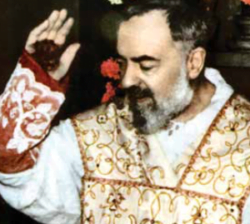 Salvatore’s son asked Padre Pio, “Father, why didn’t you heal my dad?” Padre Pio replied, “Your Dad did not want the grace of regaining his sight.” Salvatore’s son was then really upset and perplexed. The son went to his father who began to cry and explained, “That is true. I said no to Padre Pio because I heard a voice inside of me say that I should offer up my blindness to Jesus.” This experience takes us to a higher level of spirituality, of embracing suffering for other purposes. It was enough for Salvatore to realize that God had a deeper mission for him, for he was a faith filled man. Because of his handicap, Salvatore didn’t just sit in his room and twiddle his thumbs. He was very involved in the community where he lived and especially in proclaiming the faith and witnessing to a number of communists who lived there. Many were shocked and surprised by Salvatore’s deep faith and joy despite his suffering. I think Salvatore’s experience gives us a deeper explanation of Padre’s Pio’s theology. We have to live good human lives. We have to embrace whatever sufferings we have before us, and when we offer these sufferings to Jesus, we find deeper meaning in our lives. I think Salvatore’s life exemplifies that approach. On a later occasion, Salvatore was meeting with Padre Pio and touched him, praying that he would be able to see Padre Pio for a moment. That is exactly what happened. Salvatore’s blindness was lifted for a moment, and Padre Pio allowed himself to be seen by Salvatore.
Salvatore’s son asked Padre Pio, “Father, why didn’t you heal my dad?” Padre Pio replied, “Your Dad did not want the grace of regaining his sight.” Salvatore’s son was then really upset and perplexed. The son went to his father who began to cry and explained, “That is true. I said no to Padre Pio because I heard a voice inside of me say that I should offer up my blindness to Jesus.” This experience takes us to a higher level of spirituality, of embracing suffering for other purposes. It was enough for Salvatore to realize that God had a deeper mission for him, for he was a faith filled man. Because of his handicap, Salvatore didn’t just sit in his room and twiddle his thumbs. He was very involved in the community where he lived and especially in proclaiming the faith and witnessing to a number of communists who lived there. Many were shocked and surprised by Salvatore’s deep faith and joy despite his suffering. I think Salvatore’s experience gives us a deeper explanation of Padre’s Pio’s theology. We have to live good human lives. We have to embrace whatever sufferings we have before us, and when we offer these sufferings to Jesus, we find deeper meaning in our lives. I think Salvatore’s life exemplifies that approach. On a later occasion, Salvatore was meeting with Padre Pio and touched him, praying that he would be able to see Padre Pio for a moment. That is exactly what happened. Salvatore’s blindness was lifted for a moment, and Padre Pio allowed himself to be seen by Salvatore.
Marriage Advisor
Padre Pio could also discern if a given person was the right person to marry. In fact, Padre Pio gave marriage advice to a number of people who came to him. Often, he would actually tell the person whom to marry. My own mother went to Padre Pio and said, “Father, I am thinking of getting married.” Padre Pio replied, “Well, who’s there?”
My mother then mentioned her first choice. Padre Pio said, “He’s not for you. Who else is there?” My mother then mentioned her second choice. Again Padre Pio said, “He’s not for you. Who else?” Padre Pio was fishing. He knew whom God wanted my mother to marry, but Padre Pio wanted my mother to come to the answer herself. My mother then mentioned her third choice. Padre Pio replied, “The Angel of God has passed. Marry him with the blessing of God.” Apparently, Padre Pio saw the Angel of God affirming God’s will about whom my mother should marry. My mother was shocked because Padre Pio had recommended her third choice and not her first or second choice.
Later that afternoon, my mother returned to the monastery because she had forgotten to mention her fourth choice. My mother said to Padre Pio, “I forgot to mention to you that here’s another guy. I forgot to mention his name to you.” Instead of replying to my mother, Padre Pio pointed his finger to his head as though to indicate she was crazy. My father had been living in northern Italy, but returned to Pietrelcina for a visit. A mutual friend approached my father and explained that Padre Pio told my mother she should marry him. My father visited with my mother, and she asked him to go see Padre Pio. He did, and Padre Pio affirmed that they should marry. As a result, my mother married her third choice, and as of this writing, my parents have been married for over fifty years.
Internal Realizations
Padre Pio could also discern religious vocations. For example, there was a young woman whose name was Felicia. She wanted to become a religious sister. However, when she mentioned this to her family, they were dead set against it. However, Felicia was resolved to become a sister. One day Felicia was visiting her aunt who lived in Foggia, and her aunt just by chance, said, “Let’s go visit Padre Pio.” They went to the Friary to meet Padre Pio, who Felicia had never before met. Felicia and her aunt were sitting with other visitors in courtyard waiting to see Padre Pio when a friar came out of the chapel and asked, “Is there a young woman here who wants to become a sister?” Felicia froze and thought to herself, “How does he know?” The Friar then said, “Padre Pio is looking for the young girl who wants to become a sister.” Felicia was shocked, and her aunt became upset with her, saying, “Did you make an appointment to see Padre Pio without telling me?” Felicia replied, “I don’t even know Padre Pio. I’ve never met him”
The aunt and Felicia were led inside and met with Padre Pio who told Felicia that she would become a religious sister in spite of the obstacles placed by her family. Padre Pio told her that her father would eventually accept her decision and that her brother wouldn’t speak to her for more than 30 years. Padre Pio also explained to Felicia that she would have certain difficulties in community life and that at one point she would have to have heart surgery, but she would recover from it. Everything that Padre Pio told Felicia came true. She went on to become Sister Assunta.
During the 1940s, there was an Army base in Foggia, Italy, and many of our soldiers would go to visit Padre Pio. One of the soldiers was Leo Fanning. During a meeting with Padre Pio, one of Leo’s friends said, “Father, I’d like to become a religious.” Padre Pio replied, “No, you are going to get married.” Leo then said, “Father, I’d also like to get married and would like your blessing.” Padre Pio replied, “No, you are going to become a priest.” Leo had never given a thought to becoming a priest. What Padre Pio said shocked him, but that is exactly what happened. He went on to become Fr. Leo Fanning, a diocesan priest in the diocese of Patterson, New Jersey. When Padre Pio spoke he simply confirmed internal realities in the lives of the people who came to him for advice.
Hearing Confessions – Main Ministry
Hearing confessions was Padre Pio’s main ministry. In fact, sometimes he spent up to 17 hours at a time in the confessional. Padre Pio would get up very early between 1 and 2 a.m., prepare for 5a.m. Mass, pray for a while, and then begin hearing male confessions for a few hours. He would then hear female confessions until about noon. Prior to Vatican II, there was a tradition for men and women to be confessed separately. Padre Pio would then take a break and resume hearing confessions.
In the 1940’s, Padre Pio became especially popular among the local people, and a system had to be put in place to avoid having people monopolize his confessional. If someone wanted to go to confession to Padre Pio, that individual would have to go to the Friary office and obtain a ticket with a number. When your number came up, you went. There were many, many stories of Padre Pio telling people their sins, but I think that was more apt to happen with people who needed some type of spiritual awakening, particularly those people who were far from the sacraments.
Sometimes a person would formally ask Padre Pio to take them under his wing as a spiritual child. This would usually happen during confession. Padre Pio would say, “Yes, I’ll make you my spiritual child. He would also utter the same line: “Don’t embarrass me. Don’t embarrass me.” When you got to know Padre Pio’s spiritual children, the ones who really became mature in the faith, they began to walk with him in a sense. The external and the extraordinary become insignificant. What the Lord looks for and what Padre Pio looked for in his children’s lives was their obedience of faith that St. Paul talked about. That means being obedient to the Church, being obedient to the sacraments, and day-to-day fidelity. Even now, people write to San Giovanni Rotondo and ask to be made spiritual children of Padre Pio.
The concept of having a spiritual father goes back to ancient Christianity when people would encounter holy men or holy women who were very close to the Lord, and people who wanted the help, intercession, and protection of the holy person would place themselves under the guidance of that particular person. For example, in the novel The Brothers Karamazov, Fyodor Dostoevsky weaves the whole concept of spiritual fatherhood with a priest by the name of Fr. Zosima. There is a line in the novel where the author defines spiritual fatherhood. The author says a spiritual father is a man who takes your soul and your will into his soul and his will. This what Padre Pio did. When fathers and mothers have affection for their children, their parenting takes on a deeper meaning on the spiritual level. That is why we call priests “Father.” A priest is supposed to be a spiritual father who guides, protects, leads, and teaches the truth of Christ.
Before our family moved to the United States, my brother and I made our First Holy Communion with Padre Pio. After we had received our First Holy Communion, my grandfather took us upstairs into Padre Pio’s room. I can still recall him sitting there and signing our Communion certificates. Afterwards, he told us what he told all the young children who made their First Communion. Padre Pio said that he prayed our last Holy Communion would be better than our first Holy Communion. Those words have always been with me. It is a real exhortation to grow. How many times as Christians do we receive the Lord, but don’t grow? In fact, we oftentimes regress.
St. Padre Pio’s 5 Point Rule of Life
This article is from Signs and Wonders Vol. 26#1/2
Great book! Now available!
Editorial Note: For more information about Padre Pio, contact:
The National Center for Padre Pio
2213 Old Route 100
Barto, PA 19504
Tel 610-845-3000
Website: www.padrepio.org
A bi-monthly magazine, titled “The Voice of Padre Pio,” is available in English for $18.00 per year. The magazine is also available in other languages at different subscription rates.
Editorial Note: Fr. Pio Mandato’s mother wrote her memories of Padre Pio, and the book, published by AMDG (1-888-222-2634) has been translated into English. The title of the book is Padre Pio: Encounters with a Spiritual Daughter from Pietrelcina by Graziella De Nunzio.

